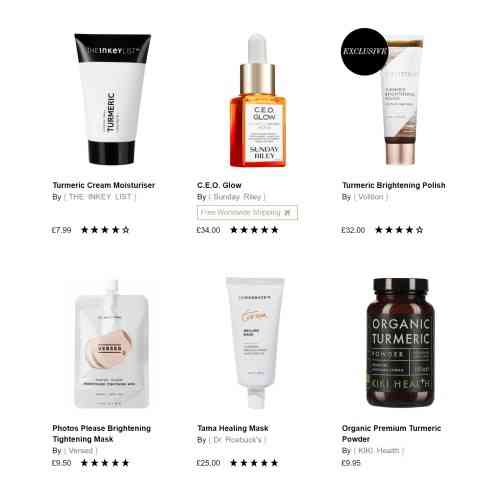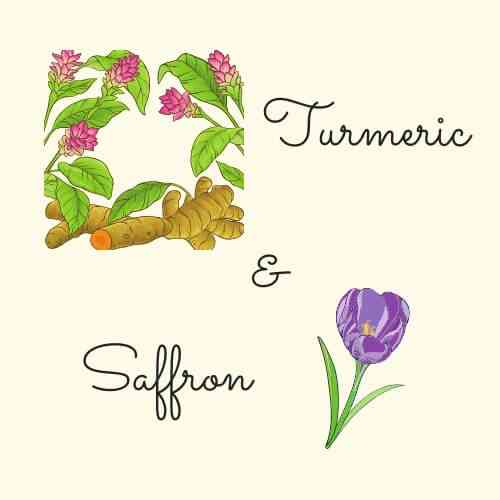In today’s blog, I’ll be considering the skin lightening ability of turmeric and saffron. Unless you have been living in an igloo off Greenland along with a few endangered species, you will have heard of at least one of these.
The rapidly increasing use of all these ingredients in Western skincare products demonstrates how Indians can completely undervalue what is right in front of them. We do so at our own economic peril. Brands such as Sunday Riley, the Inkey List, and KIKI Health are making millions from turmeric, which is found in virtually all our meals and which Indians have used for thousands of years…
Turmeric
Products containing turmeric….

Turmeric
Curcuma longa or turmeric is used as a spice in South Asia. You won’t find a kitchen without it. It’s also been used for its medicinal properties in Ayurveda as well as in China. It’s been used to improve skin texture, remove a tan and as a skin lightener.
Curcumin is the main constituent Curcuma longa and its been shown to exhibit anti-microbial, anti-oxidant, and skin-smoothing properties. In fact, its anti-oxidant properties are claimed to be more than Vitamin C!
The main challenge with using the essential oil of Curcumin longa in skincare products is this: its bio-availability in the body is very low “due to its poor absorption, fast metabolism, and rapid elimination from the body.”
Combining turmeric with pepper; heating turmeric; combining turmeric with a fat such as ghee appears to increase its bioavailability.
A study has shown that when topically applied, curcumin is delivered directly to affected tissues – based on what I just told you on its low bio-availability, its safe to say let’s just wait for more clinical studies.
As a skin lightener…
I could only find one study, which essentially looked at the anti-tyrosinase activity of Curcumin essential oil in melanoma cells. It did have an inhibitory effect on melanin synthesis via one of the hormones involved in melanin synthesis, namely Alpha Melanocyte Stimulating Hormone. The alcoholic extract of Curcumin longa has also been shown to inhibit tyrosinase enzyme in mushrooms.
What do I think?
Being Indian, I have experience of turmeric being a skin lightener – it’s used in ubtan, marriage ceremonies, etc. Naturally, that is the most biased statement on this planet….and it’s important for me to acknowledge that the scientific data on turmeric’s skin lightening ability is still not there.
Saffron (also Kesar)
Crocus sativus has been used in Ayurveda for a while now. Forest Essential’s entire Soundarya range is based on this one hero ingredient because it is excellent for your skin.
While saffron has a bunch of compounds, the precise compound (s) that are responsbile for anti-tyorsinase activity have not been identified. This is not great because the closest proxy I can find is a study that uses the methanolic extract of saffron to demonstrate tyrosinase inhibition with increasing concentration. No one is applying methanolic extracts of saffron on their skin and therefore this study is limited.
Quite frankly, I can’t find anything else on saffron’s skin lightening ability and this is disappointing.
Closing remarks
This was a really unsatisfactory blog to write. The evidence in the public domain on skin lightening potential of saffron and turmeric is limited.
BUT AS I AM CONSTANTLY reminded, that the prominence of both turmeric and saffron in Ayurveda trumps any scientific study or lack of it. Thousands of years of beauty treatments that use turmeric and saffron as skin lighteners is not a mean feat and I’ll take that experience and knowledge of our Indian heritage over any scientific study.
Any day.
Please leave a comment on your experience of using turmeric and saffron as part of your skin care routine or just generally. I would love to hear from you.
Sources and uses
Mukherjee PK, Badami S, Wahile AM, Rajan S, Suresh B. Evaluation of tyrosinase inhibitory activity of some Indian spices. J Nat Remedies. 2001;1:125–9.
Zheng Y et al Antiaging effect of Curcuma longa L. essential oil on ultraviolet-irradiated skin Microchemical Journal May 2020
Nguyen TA, Friedman AJ. Curcumin: A novel treatment for skin-related disorders. J Drugs Dermatol. 2013;12:1131–7
Lee JH, Jang JY, Park C, Kim BW, Choi YH, Choi BT. Curcumin suppresses alpha-melanocyte stimulating hormone-stimulated melanogenesis in B16F10 cells. Int J Mol Med. 2010;26:101–6. [PubMed: 20514428]
